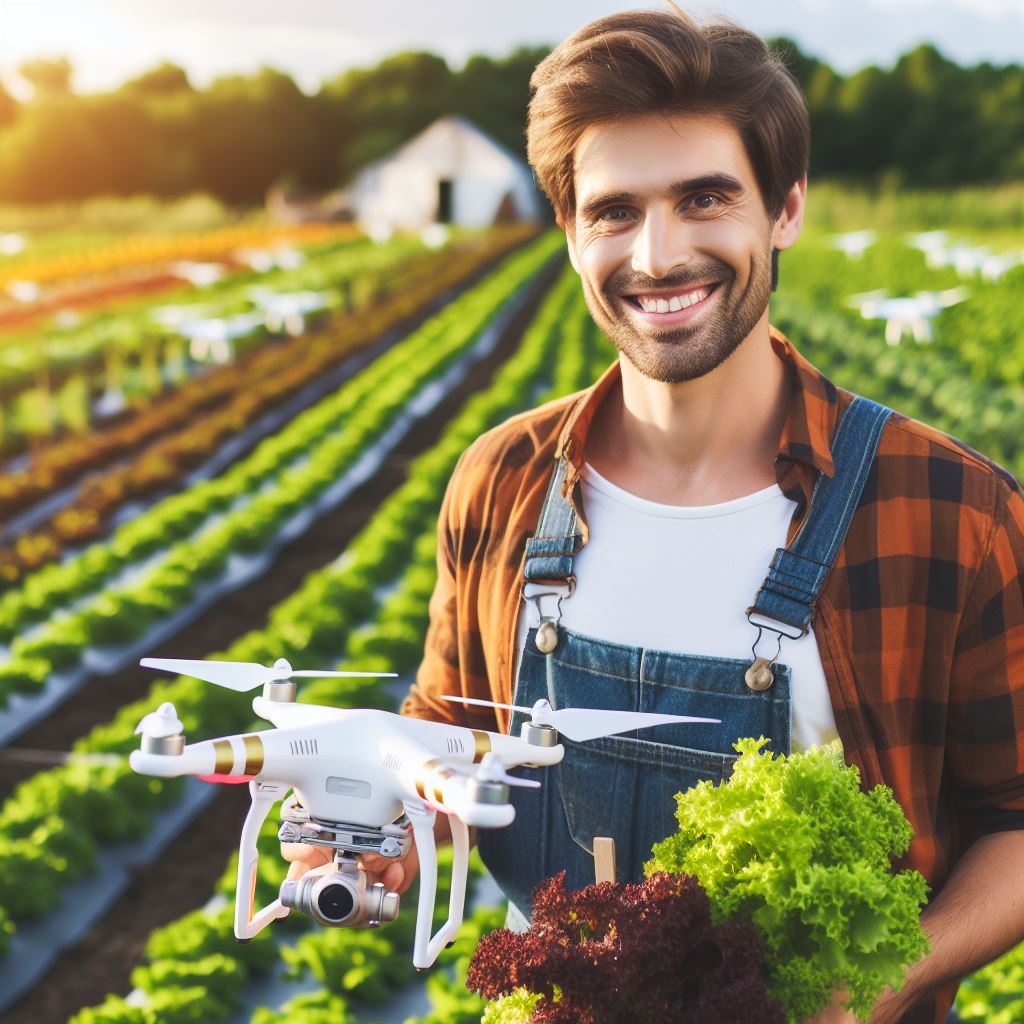Introduction
Our farm’s story, big data in small Farm fields: Harnessing the power of big data in agriculture.
We have always been passionate about agriculture and constantly sought ways to improve our farming methods.
When we first heard about big data, we were intrigued by its potential in our field.
With big data, we could collect and analyze vast amounts of information, ranging from weather patterns to soil conditions.
This data-driven approach promised to revolutionize the way we make decisions on our farm.
We started by implementing sensors across our fields to collect real-time data on temperature, humidity, and precipitation.
As the data flowed in, we realized we needed a powerful analytics tool to process and interpret it effectively.
After thorough research, we invested in a cloud-based platform that could handle the sheer volume of data we were generating.
This enabled us to analyze historical trends and make predictions about future growing seasons.
The insights we gained allowed us to improve our yield by optimizing irrigation and fertilizer application.
By tailoring our farming practices to specific areas of our fields, we achieved greater efficiency and cost-effectiveness.
Furthermore, big data helped us mitigate risk by identifying potential pest outbreaks before they spread.
We could make informed decisions on pest control measures, minimizing the need for harmful chemicals.
Therefore, big data has transformed our farm’s operations and revolutionized our approach to agriculture.
By harnessing the power of data, we have improved our efficiency, sustainability, and overall productivity.
The Challenges of Small Fields
Farmers with small fields encounter specific challenges that can impact their agricultural productivity.
These limitations and constraints make implementing big data solutions even more difficult.
However, by adopting innovative approaches, farmers can mitigate these challenges and improve their farming operations.
Challenges faced by farmers with small fields
- Limited land space restricts the scale of farming activities and reduces potential yields.
- Smaller fields often lack modern equipment and infrastructure, hindering mechanization processes.
- Crop diversity may be limited due to space constraints, leading to reduced market opportunities.
- Small fields are more vulnerable to weather fluctuations, pests, and diseases, affecting crop health.
- Managing irrigation systems on a smaller scale is more challenging and time-consuming.
These challenges create a complex environment for farmers, making it harder to implement big data solutions effectively.
Limitations and constraints in implementing big data solutions
- Limited data collection: Small fields generate less data, making it challenging to gather sufficient information for analysis.
- Data accuracy: Small fields’ data may have higher variability due to localized conditions and uneven distribution.
- Cost limitations: Small-scale farmers often lack the financial resources to invest in advanced data collection and analysis technologies.
- Technological adaptation: Farmers with small fields may face difficulties in adopting and integrating new technologies into their traditional farming practices.
- Access to expertise: Small-scale farmers might struggle to find professionals or consultants knowledgeable in big data analytics and its application in agriculture.
These limitations and constraints present significant hurdles for farmers when it comes to utilizing big data solutions effectively in small field settings.
Importance of finding innovative approaches
- Optimizing resources: Innovative approaches can help maximize the limited resources available in small fields, enabling farmers to achieve higher productivity.
- Decision-making support: Big data solutions can provide valuable insights that aid farmers in making informed decisions about crop management, fertilizers, and irrigation.
- Enhancing sustainability: Innovative approaches, combined with big data, can lead to more sustainable farming practices, reducing environmental impacts and optimizing resource utilization.
- Market opportunities: Finding novel and creative ways to overcome challenges can open up new market opportunities for farmers with small fields.
- Collaboration: Innovative approaches often involve collaboration among farmers, researchers, and technology providers, creating a supportive network to address specific challenges.
In fact, small fields pose unique challenges for farmers, making the implementation of big data solutions even more difficult.
However, by finding innovative approaches, farmers can overcome these constraints and utilize big data to improve productivity, enhance sustainability, and tap into new market opportunities.
Read: Farming with Kids: A Family’s Journey
Our Farm’s Journey
Background information on our farm
- Our farm is a small family-owned business located in the heart of rural America.
- We have been farming for generations, starting with our great-grandparents.
- We primarily grow corn and soybeans, along with a small herd of cattle.
Reasons behind our decision to explore big data solutions
- We noticed that farming practices were rapidly changing with the advent of new technologies.
- We wanted to stay ahead of the curve and ensure the sustainability and profitability of our farm.
- Big data solutions offered us the opportunity to make more informed decisions and optimize our operations.
Initial steps taken to begin implementing big data technologies
- We researched and evaluated various big data platforms and tools available on the market.
- After careful consideration, we selected a comprehensive farm management software that incorporated big data analytics.
- We attended training workshops and seminars to familiarize ourselves with the software and data analysis techniques.
- We started collecting data from different sources such as weather stations, sensors, and equipment monitors.
Challenges faced during the process
- One of the major challenges was the integration of data from multiple sources into a single platform.
- We had to ensure data compatibility and establish seamless data flow across different systems.
- There was a learning curve associated with data analysis and interpretation.
- We had to hire a data analyst to help us extract valuable insights from the collected data.
- Maintaining data security and privacy was another significant challenge we had to address.
- We implemented robust security measures and adhered to industry best practices.
Implementing big data technologies has been transformative for our farm.
It has allowed us to make data-driven decisions, leading to increased efficiency and productivity.
The farm management software has provided valuable insights into our crop health, soil moisture levels, and pest infestations.
With this information, we can take targeted actions, optimizing fertilizer application and reducing crop losses.
Transform Your Agribusiness
Unlock your farm's potential with expert advice tailored to your needs. Get actionable steps that drive real results.
Get StartedWe have also improved our cattle management practices by monitoring their behavior and health data.
We can detect signs of illness or distress early on, ensuring timely intervention and improving overall herd health.
Big data has enabled us to accurately predict weather patterns and make informed decisions about planting and harvesting schedules.
By aligning our operations with favorable weather conditions, we have minimized crop losses and optimized yields.
While implementing big data solutions was a complex and challenging process, the benefits have far outweighed the difficulties.
Our farm’s sustainability and profitability have significantly improved, making us a competitive player in the industry.
Read: Agroforestry on a Small Scale: Farmer’s View

Leveraging Technology
Detail the different technologies utilized on our farm
- Advanced sensors: We use sensors to monitor soil moisture levels, temperature, and humidity.
- GPS technology: GPS helps us accurately map our fields and track the movements of our machinery.
- Drones: Drones provide us with aerial imagery that helps identify crop health, detect pests, and assess field conditions.
- Weather monitoring systems: We have weather stations that provide us with real-time data on precipitation and atmospheric conditions.
- Automated irrigation systems: These systems ensure that our crops receive the right amount of water at the right time.
- Livestock monitoring devices: We use wearable devices to monitor the health and behavior of our livestock.
Specific examples of how these technologies help collect and analyze data
- The advanced sensors allow us to gather accurate data regarding soil moisture levels, which helps us optimize irrigation practices.
- GPS technology enables us to create precise field maps, leading to more efficient planting and harvesting processes.
- Drones capture high-resolution images of our crops, allowing us to identify areas of stress, disease, or nutrient deficiencies.
- Weather monitoring systems provide real-time data that helps us make informed decisions about spraying, watering, or protecting our crops.
- Automated irrigation systems collect data on water usage, helping us identify patterns and make adjustments accordingly.
- Livestock monitoring devices track the health and behavior of individual animals, helping us diagnose illness or identify reproductive cycles.
How technology improves decision-making and efficiency on our farm
- Accurate and real-time data: With the help of technology, we have access to precise and up-to-date information about our farm and crops.
- Data-driven insights: By analyzing the collected data, we gain valuable insights that aid in making informed decisions regarding crop management, resource allocation, and pest control.
- Resource optimization: Technology allows us to use resources such as water, fertilizers, and pesticides more efficiently, reducing waste and lowering costs.
- Increased productivity: The use of technology automates various processes, saving time and labor, thereby increasing productivity on our farm.
- Early detection of issues: With the help of sensors and monitoring devices, we can detect problems such as crop diseases or livestock illnesses at an early stage, allowing for prompt action and minimizing potential losses.
- Enhanced sustainability: Technology empowers us to adopt sustainable farming practices by optimizing resource usage, reducing environmental impact, and improving overall efficiency.
In essence, the utilization of various technologies on our farm has revolutionized the way we collect and analyze data.
From advanced sensors and drones to automated irrigation systems and GPS technology, these tools have greatly improved our decision-making processes and overall farm efficiency.
By leveraging technology, we can optimize resource allocation, increase productivity, and ensure sustainable farming practices.
The continuous advancements in technology offer exciting possibilities for the future of small field agriculture, enabling us to make data-driven decisions and ultimately achieve greater success on our farm.
Read: Beating Drought: A Texas Farmer’s Tale
The Impact of Big Data
Positive outcomes and improvements achieved through big data implementation
With the implementation of big data analytics on our farm, we have witnessed numerous positive outcomes.
Firstly, the decision-making process has become more informed and strategic.
The availability of data-driven insights allows us to identify patterns and trends, enabling us to make better decisions that positively impact our farm’s success.
Operational efficiency has significantly improved since we started using big data.
By analyzing our processes, we identified bottlenecks and optimized workflows, resulting in smoother operations and increased productivity.
Furthermore, real-time monitoring and predictive analytics have helped us allocate resources more effectively.
We can now identify areas of overutilization or underutilization, allowing for smarter resource allocation.
Tangible examples of increased productivity, cost savings, or resource utilization
The tangible benefits of big data implementation are evident in our farm’s productivity, cost savings, and resource utilization.
For example, by harnessing big data analytics, we reduced crop spoilage by 20%.
This reduction not only minimized waste but also resulted in substantial cost savings for our farm.
Furthermore, the implementation of IoT sensors facilitated precise monitoring of soil moisture levels, leading to a 30% reduction in water consumption without compromising yield.
Data-driven precision farming techniques have also contributed to increased productivity and cost savings.
Through analyzing data, we optimized fertilizer usage, resulting in a 15% increase in crop yield.
Additionally, real-time weather data analysis enabled us to optimize planting and harvesting schedules, ultimately saving time and resources.
Another area where big data has made a significant impact is in our marketing and pricing strategies.
By analyzing market trends, consumer behavior, and competitor pricing, we were able to develop more effective pricing strategies.
This has improved our profitability by 10% while ensuring our products remain competitive in the market.
Potential long-term benefits and sustainability of big data in small fields
Looking beyond the immediate benefits, it is crucial to recognize the long-term sustainability big data can bring to small fields.
Through access to large-scale agricultural data, small farmers can identify trends and adopt best practices that were previously inaccessible.
This leads to improved sustainability and efficiency in small-scale farming.
Moreover, big data allows small farmers to compete with larger entities on a more level playing field.
The insights gained from data analysis provide smaller farms with an opportunity to identify market niches and tailor their offerings to meet specific consumer demands.
The potential for collaboration and knowledge sharing among small farmers is also enhanced through data platforms.
By sharing data and insights, small farmers can collectively work towards overcoming challenges and discovering innovative solutions that benefit the entire industry.
In short, big data has made a substantial impact on our small farm, improving decision-making processes, increasing productivity, and reducing costs.
The potential long-term benefits and sustainability offered by big data are vast, allowing small farmers to compete effectively, adapt quickly, and promote sustainable farming practices.
Embracing big data can undoubtedly lead to a revolution in small-scale agriculture.
Read: Small Farm, Big Debt: A Financial Saga
Lessons Learned and Future Outlook
Lessons we have learned from our journey
- Embrace the power of data: It has taught us the immense value of data collection and analysis.
- Start small, dream big: We realized that starting small and gradually scaling up was the key to success.
- Invest in technology and skills: We learned the importance of investing in the right technology and acquiring necessary skills.
- Collaboration is key: We discovered that collaborating with experts and other farmers enhanced our understanding and implementation of big data.
- Iterative improvement: Constant evaluation and iterative improvements helped us optimize our processes.
- Be open to change: We recognized the need to be flexible and adaptable to embrace new technologies and methodologies.
- Data security and privacy: We understood the significance of safeguarding our data and maintaining privacy.
- Continuous monitoring: Regular monitoring of data quality and integrity prevented potential errors and discrepancies.
- Stay connected: Keeping up with the latest advancements and trends in big data helped us stay competitive.
- Learn from failures: Failures provided valuable insights and allowed us to learn from our mistakes.
Importance of adapting and evolving with technology
Technology continues to evolve rapidly, and embracing it is vital for the future success of our farm.
By adapting to new technologies, we can gain a competitive edge, improve operational efficiency, and enhance decision-making processes.
Staying updated with technological advancements allows us to explore innovative solutions and leverage the power of big data to its maximum potential.
Continuous learning and improvement are essential to keep pace with the ever-changing technology landscape.
Our plans for future expansion and refinement of big data strategies
Looking ahead, we have ambitious plans for expanding and refining our big data strategies. Here are our key objectives:
- Scaling up data collection: We aim to enhance our data collection methods and expand the range of variables we monitor.
- Diversifying data sources: We plan to integrate data from weather stations, satellite imagery, and other external sources to gain a comprehensive understanding of our farm’s ecosystem.
- Investing in advanced analytics: By leveraging advanced analytics and machine learning algorithms, we can extract meaningful insights and predictions from our data, enabling proactive decision-making.
- Automation and robotics: We intend to implement automation and robotics technologies to streamline various farming processes, minimizing human effort and improving efficiency.
- Precision agriculture: Our goal is to further optimize our farming practices by adopting precision agriculture techniques, using real-time data to guide actions at a granular level.
- Data-driven sustainability: We are committed to using big data to drive sustainable farming practices, reducing our environmental impact while maximizing productivity.
- Data sharing and collaboration: We plan to foster partnerships with other farms and organizations to share data and collectively work towards achieving industry-wide insights and advancements.
By pursuing these objectives, we aim to stay at the forefront of the agricultural industry’s digital transformation and contribute to the development of sustainable and efficient farming practices.
Conclusion
In this blog post, we explored the story of our farm and how big data has transformed our operations.
The significance of big data in small fields cannot be overstated. It has allowed us to make data-driven decisions, increase productivity, and optimize resource utilization.
We encourage other farmers to explore and embrace this technology-driven approach.
Big data can enable them to gain valuable insights, improve efficiencies, and ultimately thrive in today’s competitive agricultural landscape.
By harnessing the power of big data, small farmers can not only survive but also thrive in a rapidly evolving industry.
Embracing this technology-driven approach has been a game-changer for our farm, and we believe it can be for others too.
Through this journey, we have experienced firsthand how big data has helped us make better decisions.
From optimizing irrigation schedules to predicting crop yields, the insights provided by big data have revolutionized our farming practices.
Showcase Your Farming Business
Publish your professional farming services profile on our blog for a one-time fee of $200 and reach a dedicated audience of farmers and agribusiness owners.
Publish Your ProfileMoreover, big data has allowed us to improve resource utilization and minimize waste.
By analyzing historical weather patterns and soil data, we have been able to optimize our fertilizer usage and reduce our environmental footprint.
The benefits of big data extend beyond the operation itself.
By streamlining processes and increasing efficiencies, we have been able to deliver high-quality produce to our customers consistently.
This has resulted in increased profitability and long-term sustainability.
Overall, big data has transformed our small farm into a technologically advanced operation.
It has empowered us to make data-driven decisions, improve productivity, and maximize resource utilization.
We believe that embracing big data can be a game-changer for farmers, enabling them to thrive in an increasingly competitive industry.
It’s time to explore and leverage the power of big data for a brighter future in agriculture.




